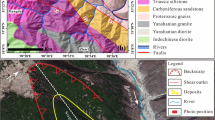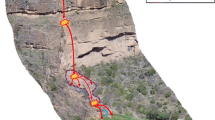Abstract
The 2D discrete element method has been employed to analyze the dynamic fragmentation characteristics of the Zengziyan columnar rockfall that occurred in Chongqing, China, in 2004. In this study, characteristics of particle morphometric distribution of the simulation were verified by a new image analysis method. The simulated runout behavior of the Zengziyan columnar rockfall was validated by the video analysis method. The numerical results of this study showed that the maximum velocity of the rockfall mass was 40 m/s, and the entire dynamic process lasted approximately 27 s. Fragments were identified in the numerical model on the basis of the presence or absence of cement between particles. The results showed that the fragmentation of the Zengziyan rockfall mainly occurred when the bottom of the rockfall mass broke, and during the collision process along the runout path. However, during the accumulation process, the rockfall mass barely fragmented. The results of fitting the cumulative distribution of fragment size showed that their fractal dimension \({\text{D}}\) increased (from 2.05 to 2.12), and the fragment scale parameter \({d}_{c}\) decreased significantly (from 15.84 to 3.77) before and after the rockfall, respectively. Thus, it was confirmed that the rockfall mass underwent significant fragmentation and produced many fine fragments during the initiation stage, and fragmentation lessened during the transport stage along the runout path. Moreover, the increasing fractal dimension of particles indicated the enhanced mobility of the rockfall, which may be explained by the volume amplification caused by fragmentation. These findings of this research provide original insight into the study of the dynamic fragmentation process of similar rockfall hazards from the perspective of particle size distribution, which provides guidance for the disaster management.

















Similar content being viewed by others
Data Availability
The authors confirm that the data supporting the findings of this study are available within the article.
References
Boultbee N, Stead D, Schwab J et al (2006) The Zymoetz River rock avalanche, June 2002, British Columbia, Canada. Eng Geol 83(1/3):76–93
Bowman ET, Take WA, Rait KL, Hann C (2012) Physical models of rock avalanche spreading behaviour with dynamic fragmentation. Can Geotech J 49(4):460–476
Crosta GB, Frattini P, Fusi N (2007) Fragmentation in the Val Pola rock avalanche, Italian Alps. J Geophys Res 112:F01006
Crosta GB, Imposimato S, Roddeman D (2009) Numerical modeling of 2-D granular step rockfall on erodible and nonerodible surface. J Geophys Res 114:F03020
Davies TR, Mcsaveney MJ (2002) Dynamic simulation of the motion of fragmenting rock avalanches. Can Geotech J 39(4):789–798
Davies TRH, McSaveney MJ (1999) Runout of dry granular avalanche. Can Geotech J 36(2):313–320
De Blasio F, Crosta GB (2015) Fragmentation and boosting of rock falls and rock avalanches. Geophys Res Lett 42:8463–8470
Dufresne A, Dunning SA (2017) Process dependence of grain size distributions in rock avalanche deposits. Landslides 14(5):1555–1563
Erismann TH, Abele G (2001) Dynamics of rockslides and rockfalls. Springer, Berlin
Gao G, Meguid MA, Chouinard LE, Xu C (2020) Insights into the transport and fragmentation characteristics of earthquake-induced rock avalanche: numerical study. Int J Geomech 20(9):04020157
Hadley JB (1964) Landslides and related phenomena accompanying the Hebgen Lake earthquake of August 17, 1959. US Geol Survey 435-K:107–138
He K, Chen CL, Li B (2018) Case study of a rockfall in Chongqing, China: movement characteristics of the initial failure process of a tower-shaped rock mass. Bull Eng Geol Env 78:3295–3303
He K, Yin YP, Li B, Chen CL (2019) The mechanism of the bottom-crashing rockfall of a massive layered carbonate rock mass at Zengziyan, Chongqing. China J Earth Syst Sci 128:104
Huang BL, Wang J, Zhang Q, Luo CL, Chen XT (2020) Energy conversion and deposition behaviour in gravitational rockfall of granular columns. J Mt Sci 17(1):216–229
Huang RQ (2009) Some catastrophic landslides since the twentieth century in the southwest of China. Landslides 6(1):69–81
Hungr O, Leroueil S, Picarelli L (2014) The Varnes classification of landslide types, an update. Landslides 11(2):167–194
Jin KP, Xing AG, Chang WB, He JY, Gao G, Muhammad B, Zhang YB, Zhuang Y (2022) Inferring dynamic fragmentation through the particle size and shape distribution of a rock avalanche. J Geophys Res Earth Surf 127(11). https://doi.org/10.1029/2022JF006784
Johnson B (1987) Blackhawk landslide, California, USA. In Rockslides and avalanches //B Voight (eds.), Rockslides and Avalanches, Netherlands 14:481–504
Lai ZQ, Vallejo LE, Zhou W, Ma G, Espitia JM, Caicedo B, Chang XL (2017) rockfall of granular columns with fractal particle size distribution: Implications for understanding the role of small particles in granular flows. Geophys Res Lett 44:12181–12189
Langlois VJ, Quiquerez A, Allemand P (2015) rockfall of a two-dimensional brittle granular column: Implications for understanding dynamic rock fragmentation in a landslide. J Geophys Res: Earth Surf 120:1866–1880
Legros F (2002) The mobility of long-runout landslides. Eng Geol 63(3–4):301–331
Lin QW, Cheng QG, Li K, Xie Y, Wang YF (2020) Contributions of rock mass structure to the emplacement of fragmenting rockfalls and rockslides: insights from laboratory experiments. J Geophys Res: Solid Earth 125(4):e2019JB019296
Liu C, Pollard DD, Shi B (2013) Analytical solutions and numerical tests of elastic and failure behaviors of close-packed lattice for brittle rocks and crystals. J Geophys Res: Solid Earth 118(1):71–82
Locat P, Couture R, Leroueil S, Locat J, Jaboyedoff M (2006) Fragmentation energy in rock avalanches. Can Geotech J 43(8):830–851
Lube G, Huppert EH, Sparks S, Hallworth M (2004) Axisymmetric rockfall of granular columns. J Fluid Mech 508:175–199
Lube G, Huppert EH, Sparks S, Freundt A (2005) rockfalls of two-dimensional granular columns. Phys Rev E Stat Nonlin Soft Matter Phys 72:041301
Luzio ED, Biachi-Fasani G, Esposito C et al (2004) Massive rock-slope failure in the Central Apennines (Italy): the case of the Campo di Giove rock avalanche. Bull Eng Geol Env 63(1):1–12
Mugnozza GS, Fasani GB, Esposito C (2006) Rock avalanche and mountain slope deformation in a convex dip-slope: the case of the Maiella massif, central Italy. Evans SG et al (eds.), Landslides from Massive Rock Slope Failure, Netherlands 357–376
Sarocchi D, Sulpizio R, Macias JL, Saucedo R (2011) The 17 July 1999 block-and-ash flow (baf) at colima volcano: new insights on volcanic granular flows from textural analysis. J Volcanol Geoth Res 204(1):40–56
Staron L, Hinch J (2005) Study of the rockfall of granular columns using DEM numerical simulation. J Fluid Mech 545:1–27
Terzaghi K (1950) Mechanism of landslides. Application of geology to engineering practice. Geol Soc Am 83–123
Turcotte DL (1986) Fractals and fragmentation. J Geophys Res: Solid Earth 91(B2):1921–1926
Tyler SW, Wheatcraft SW (1992) Fractal scaling of soil particle size distributions: analysis and limitations. Soil Sci Soc Am J 56:362–369
Watson RA, Wright HE (1967) The Saidmarreh landslide. Iran Geol Soc Am 123:115–139
Weibull W (1951) A statistical distribution function of wide applicability. J App Mech 18:293–297
Wu Y, Li XP, Zhu L (2021) Fracture mechanism of rockfall in the freeze–thaw zone of the eastern Sichuan-Tibet Mountains under seasonal fluctuating combinations of water and heat. Nat Hazards 108:2309–2333
Zhao T, Crosta GB, Utili S, De Blasio FV (2017) Investigation of rock fragmentation during rockfalls and rock avalanches via 3-D discrete element analyses. J Geophys Res Earth Surf 122(3):678–695
Zhao T, Crosta GB, Dattola G, Utili S (2018) Dynamic fragmentation of jointed rock blocks during rockslide-avalanches: insights from discrete element analyses. J Geophys Res: Solid Earth 123(4):3250–3269
Zhou YY, Shi ZM, Zhang QZ et al (2019) 3D DEM investigation on the morphology and structure of landslide dams formed by dry granular flows. Eng Geol 258
Zhu YQ, Xu SM, Zhuang Y, Dai XJ, Lv G, Xing AG (2019) Characteristics and runout behaviour of the disastrous 28 August 2017 rock avalanche in Nayong, Guizhou, China. Eng Geol 259:105154
Funding
This study was supported by the National Key R&D Program of China (Grant No. 2018YFC1504804) and the National Natural Science Foundation of China (Grant No. 41977215).
Author information
Authors and Affiliations
Corresponding author
Supplementary Information
Below is the link to the electronic supplementary material.
Rights and permissions
Springer Nature or its licensor (e.g. a society or other partner) holds exclusive rights to this article under a publishing agreement with the author(s) or other rightsholder(s); author self-archiving of the accepted manuscript version of this article is solely governed by the terms of such publishing agreement and applicable law.
About this article
Cite this article
Jin, K., Xing, A., Li, B. et al. Dynamic fragmentation characteristics of columnar rockfall: insights from discrete element method. Bull Eng Geol Environ 82, 322 (2023). https://doi.org/10.1007/s10064-023-03341-x
Received:
Accepted:
Published:
DOI: https://doi.org/10.1007/s10064-023-03341-x




